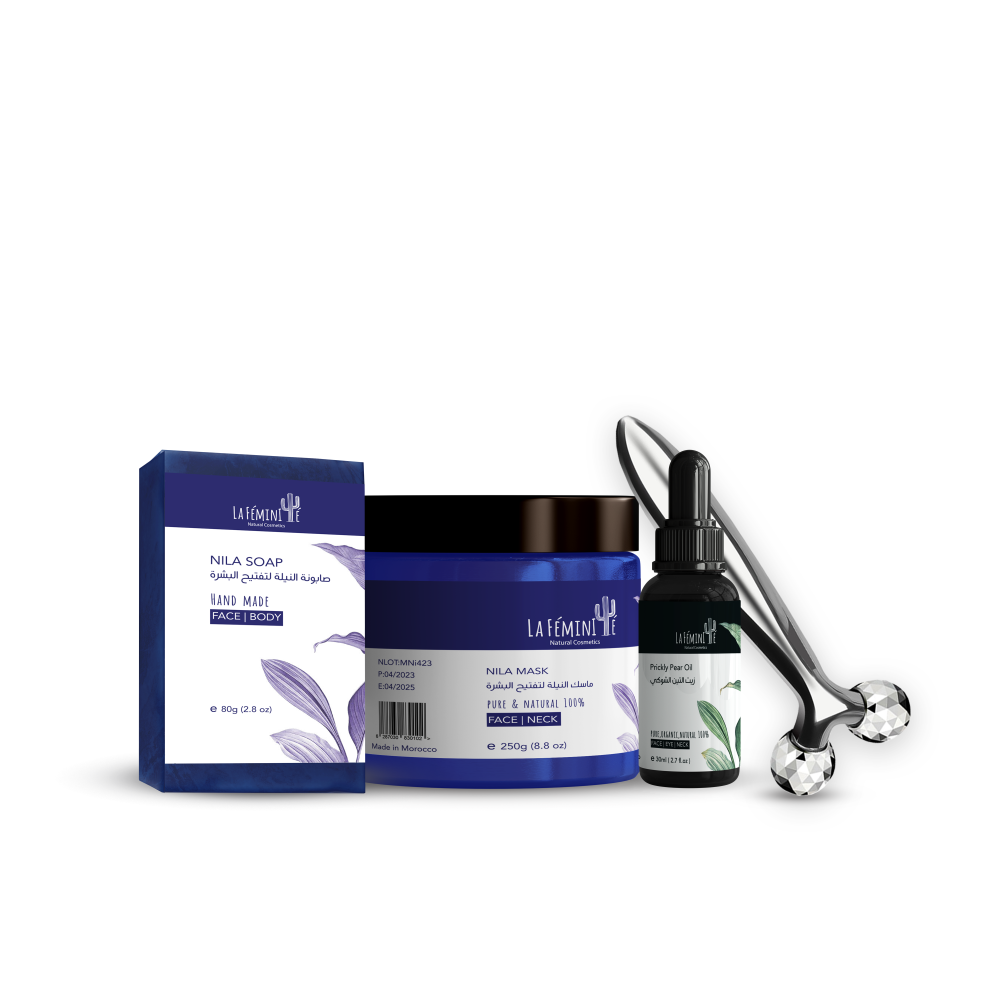Oily skin is a common challenge that many people face, as this type of skin is characterized by an excess secretion of natural oils, which leads to problems such as excess shine and the appearance of blackheads. In this article, we will take an in-depth look at the signs and causes of oily skin, and provide the best ways to care for it. By understanding the factors that affect oily skin and applying the right care, the appearance and health of this skin type can be greatly improved. We will discover the most important steps and products to use to maintain the balance of the skin and avoid annoying problems.
From moisturizers to clay masks, from prickly pear oil to blue indigo, here is everything you need to build an effective skincare routine for your oily skin. Don’t miss out on these helpful tips and information that will help you maintain healthy, balanced skin.
What is oily skin?
Oily skin is a type of skin characterized by excessive secretion of natural oils by the sebaceous glands in the skin. This skin is prone to shine and luster, and may be accompanied by the appearance of blackheads and whiteheads in a noticeable way.
Oily skin is one of the most common skin types, due in part to genetic and hormonal factors. Oily skin needs special care to maintain its balance, including using mild, appropriate cleansing products and applying light, non-greasy moisturizers.
Being aware of the factors that affect the condition of oily skin and following a proper care regimen can help improve its appearance and health in the long run.
Signs and causes of oily skin
The most prominent signs of oily skin are excessive shine, large pores, and acne or blackheads. These signs are most noticeable in the forehead, nose, and chin area, known as the T-zone.
Oily skin can be caused by a number of factors, including genetics, hormonal changes, and environmental factors. An unbalanced diet and stress can play a role in increasing oil production. Using products that aren’t suitable for oily skin, such as heavy creams or harsh cleansers, can also aggravate the problem.
Best ways to care for oily skin
Using moisturizers is an essential step in caring for oily skin. Despite the common belief that oily skin does not need moisturizing, this is not true. Moisturizing creams designed specifically for oily skin help balance sebum production and maintain skin moisture without increasing shine.
It is preferable to choose creams that contain ingredients such as hyaluronic acid, niacinamide, or glycerin, which provide light, non-greasy hydration.
When choosing moisturizers for oily skin, it is best to make sure that they are oil-free and non-comedogenic. These creams can be used twice daily, morning and evening, to achieve an ideal balance between moisture and oil levels in the skin.
For best results, it is recommended to follow a daily routine that includes cleansing the skin twice daily using an oily skin cleanser. It is preferable to use a cleanser that contains ingredients such as salicylic acid or activated charcoal, as these ingredients help remove dirt and excess oils from the skin.
Exfoliate your skin once or twice a week with exfoliants containing salicylic acid to remove dead cells and help unclog and deeply clean pores. After cleansing, a toner can be used to remove any residue and regulate the pH level of the skin.
Don't forget to use sunscreen daily to protect your skin from UV damage. Choosing a sunscreen with a light, non-greasy formula can be an excellent choice for oily skin.
Additionally, it is recommended to apply a clay mask once or twice a week, such as the Fassi Akr Mask with Red Clay, to help absorb oils and deeply cleanse pores. Prickly pear oil can be combined with the mask for additional benefits, as it helps soothe the skin and reduce inflammation.
Benefits of prickly pear oil for oily skin
Prickly pear oil is an excellent ingredient that can be part of your oily skincare routine with its antioxidant properties that help regenerate skin cells and reduce the appearance of pimples, in addition to its high content of vitamin E and essential fatty acids that deeply moisturize the skin. Prickly pear oil also helps regulate the secretion of natural oils in the skin, which reduces shine and prevents clogged pores.
Using prickly pear oil as part of your skincare routine can be simple and effective. Apply a few drops of this oil to your face after cleansing and gently drying it, then massage it in circular motions until it is completely absorbed. It can be used alone or before applying moisturizers for oily skin.
How to use indigo to lighten oily skin
Blue indigo is an effective natural ingredient in lightening oily skin and improving its appearance, thanks to its antioxidant and anti-inflammatory properties. To use blue indigo to lighten the skin effectively, specific steps must be followed to ensure achieving the best results.
- First: It is recommended to clean the skin well using a suitable oily skin cleanser. The cleanser helps remove dirt and excess oils that may hinder the absorption of blue indigo. After that, you can prepare a blue indigo mask by mixing indigo powder with a small amount of water to obtain a smooth paste.
- Second: It is preferable to apply the mask on slightly damp skin to ensure better absorption. The mask can be left for 15 to 20 minutes, then washed well with lukewarm water. It is important to avoid using hot water, as it can further dry out oily skin.
- Third: After removing the mask, you should use moisturizing creams for oily skin to maintain the necessary hydration. You can choose a cream that contains ingredients such as aloe vera or hyaluronic acid, as these ingredients contribute to moisturizing the skin without increasing shine or causing clogged pores.
For noticeable results, it is recommended to use the blue indigo mask once or twice a week, in addition to a daily skincare routine that includes an oily skin cleanser and suitable moisturizing creams. Adhering to this routine helps improve the appearance of oily skin and reduce blemishes and dark spots over time.
In addition, prickly pear oil can be combined with blue indigo. A few drops of prickly pear oil can be mixed with blue indigo powder and applied as a face mask for 15-20 minutes, then washed off with lukewarm water. This mixture helps achieve the perfect balance between moisturizing the skin and regulating sebum secretion, in addition to lightening the skin and giving it a natural glow.
Always remember to test these products on a small patch of skin first to make sure there is no allergic reaction.
Benefits of blue indigo for the skin
- Blue indigo contains antioxidants that fight signs of aging and reduce the appearance of wrinkles.
- It works to enhance collagen production in the skin, which enhances its youthfulness and freshness.
- It contains soothing and moisturizing properties that help calm irritated skin and deeply moisturize it.
- Suitable for all skin types, it particularly improves the condition of dry and sensitive skin.
These simple yet effective tips can make a huge difference in the health and appearance of your oily skin, leaving it looking fresher and more radiant. Don’t be afraid to experiment with different products until you find what works for you, and always remember that caring for oily skin requires a combination of attention and the right products.
Lavment offers a variety of skin care creams for oily skin extracted from nature. Choose what suits you today and restore youth and vitality to your face.


